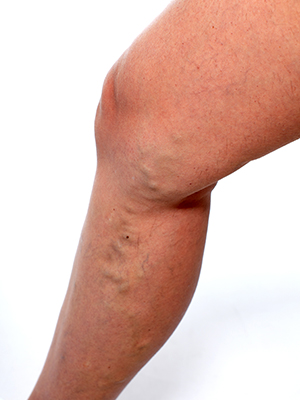There are two kinds of vein conditions that most of us are aware of. There are “spider” veins that resemble “granddaddy long legs” and may be unappealing to some who have them. They are strictly a cosmetic issue. Varicose veins—which cause discomfort—are the kind that protrude and can look almost like a rope beneath the skin.
Dr. Ray Workman, with Novant Health Vascular Specialists in Winston-Salem, explains the causes and treatment.
 What exactly are symptomatic varicose veins?
What exactly are symptomatic varicose veins?
Symptomatic veins are ones that cause pain, swelling, aching, severe bruising, and external bleeding or sores, also known as ulceration. Often these symptoms will interfere with daily activities such as working or exercising, but not all varicose veins become symptomatic.
What level of pain is associated with varicose veins?
It can range from mild, intermittent pain to severe pain and swelling that limits activities. Patients with ulcers can have severe pain every day.
What causes the condition?
Varicose veins are almost always caused by “reflux” or backward blood flow in the veins. The veins should be carrying blood from the legs back to the heart. Patients with varicose veins develop reflux when the valves in their veins break or become dysfunctional. This can be caused by heredity, obesity or occupations that require prolonged standing, such as hairdressers, teachers, and cashiers. They can also develop during pregnancy and may worsen with subsequent pregnancies.
Who might develop symptomatic varicose veins? Are they more common in women than men?
Both sexes are affected, but it’s slightly more common in women. I see patients as young as 20 and as old as 90.
How do you treat it?
First-line treatment is to compress the veins from the outside using compression stockings. For many patients, that’s all that’s required. Weight loss, exercise and leg elevation can also help with symptoms.
If these measures don’t work, surgery is the next option. Ninety percent of the vein surgery I do is done in the office. The standard procedure is to close off the “problem” vein. With this ablation procedure, blood is permanently routed through the larger vein in the leg to get back to the heart. Only the painful superficial vein is closed.
We close the superficial vein with heat that causes the vein to collapse and close. (Remember: The blood has already been rerouted.) We do this using radiofrequency energy to generate the heat on the tip of a catheter inserted into the vein. It can be done under local anesthesia in about 45 minutes, and with little to no pain.
Sometimes we have to remove segments of the vein through phlebectomy, which is also done in the office under local anesthesia. If ablation doesn’t work, we can use a small incision and a hook to remove diseased segments.
Finally, some veins–usually smaller ones–can be treated with sclerotherapy. This involves injecting a medication into the vein that causes it to collapse. It’s the same procedure we use on spider veins–which are treated for cosmetic reasons only.
How long could it take to get rid of the varicose veins entirely?
The process of determining the cause, treating them conservatively at first and then surgically, if needed, can take three to six months. There are insurance requirements that can sometimes dictate a longer course.
So, insurance does cover treatment?
Most insurance plans cover treatment of symptomatic varicose veins. But they want to see that conservative treatment was tried for three to six months without success.
Do symptomatic varicose veins sometimes indicate an underlying condition?
Varicose veins can slightly increase the risk for developing a blood clot in the deep vein of the leg–a condition known as deep vein thrombosis, or DVT. This is a serious, sometimes life-threatening condition. However, having varicose veins doesn’t mean you will develop a DVT. Exercise and compression stockings are the best ways to avoid developing a DVT.
What else should people know?
There is no reason for patients to delay evaluation and treatment if their varicose veins are causing symptoms. Treatments continue to evolve. New outpatient procedures are just as effective as previous methods and allow patients to return to normal activities almost immediately.
By Page Leggett. Reprinted courtesy of Novant Health.

